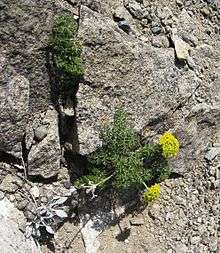Cymopterus terebinthinus
Cymopterus terebinthinus is a perennial plant in the carrot family Apiaceae with leaves that look like parsley and grows in the Great Basin of the American West.[1] Common names include Aromatic spring-parsley, northern Indian parsnip, and turpentine cymopterus.
| Cymopterus terebinthinus | |
|---|---|
 | |
| Scientific classification | |
| Kingdom: | |
| Phylum: | |
| Class: | |
| Order: | |
| Family: | |
| Genus: | |
| Species: | C. terebinthinus |
| Binomial name | |
| Cymopterus terebinthinus | |
Name
Cymopterus means "wavy ring", referring to the fruit. Terebinthinus ('of turpentine') refers to the pungent smell of the plant's oil.[1]
Description
Growth pattern
It is a low growing perennial plant from 1⁄2 to 2 feet (0.15 to 0.61 m) tall, spreading out from a woody base.[1]
Leaves and stems
Leaves are 1⁄2 to 8 inches (1.3 to 20.3 cm) long.[1] Leaves are ovate overall, but finely pinnately dissected into segments like parsley leaves.[1] Leaves are strongly aromatic when crushed.[1] "Terebinthus" means "like-turpentine", referring to the scented oils in the plant.[1]

Habitat and range
It grows on dry, sandy or rocky slopes, typically around rocks, from 5,000 to 9,000 feet (1,500 to 2,700 m) in sagebrush steppe and montane plant communities of the Great Basin.[1] It can be found in the Toiyabe Range and Deep Creek Mountains.[1]
Ecology
It is a host for Papilio indra.[2]
Some Plateau Indian tribes chewed the roots to treat colds and sores.[3]
References
- Blackwell, Laird R. (2006). Great Basin Wildflowers: A Guide to Common Wildflowers of the High Deserts of Nevada, Utah, and Oregon (A Falcon Guide) (1st ed.). Guilford, Conn.: Morris Book Publishing, LLC. p. 108. ISBN 0-7627-3805-7. OCLC 61461560.CS1 maint: date and year (link)
- Tips on Collecting and Rearing Immatures of 375 Butterfly and Skipper Taxa (pdf), The Taxonomic Report of the International Lepidoptera Society, 2-1-2010.
- Hunn, Eugene S. (1990). Nch'i-Wana, "The Big River": Mid-Columbia Indians and Their Land. University of Washington Press. p. 353. ISBN 0-295-97119-3.
